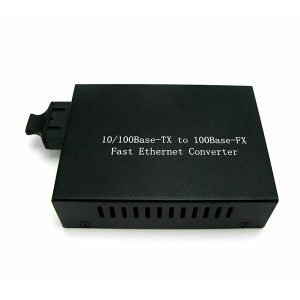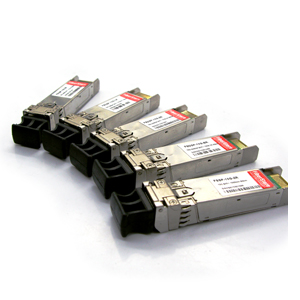What is an Optical Transceiver module?
Optical Transceiver
is a computer chip that uses fiber optic technology to communicate
between other devices. This is opposed to a chip that transfers
information electrically through metal wires and circuits or by the
process of using various wave forms to communicate data. An optical
transceiver chip is an integrated circuit (IC) that transmits and
receives data using optical fiber rather than electrical wire.
Optical
transceivers are typically used to create high bandwidth links between
network switches. With the optical transceiver you can also create data
transmission links capable of long range transmission.
Tips: Click here to know about the jargons related to fiber optic transceivers.
Development of Optical Transceiver Modules
Optical
transceivers play an important role in conveying information across
communication channels for Ethernet systems. They act as the all-in-one
objects that receive and convey inforamtion, similar to those found in
radios and telephone systems. With an optical transceiver, networks save
much more space and avoid the need of having a transmitter and receiver
apart inside a network. Capable of transmitting information further and
faster than older models, the newer transceivers continue to change the
way transceivers are used and appear, making for smaller, more compact
modules than before. Here is a simple development of the transceivers.
Earliest Modules SFP Module
is one of the earliest transceiver devices which were created for
Gigabit Ethernet networks and were preferred for their hot-swappable
abilities. GBIC, or Gigabit interface Converters, allowed networks the
ability to transmit data across copper or fiber-optic channels, creating
a more versatile device than transmitters and receivers. Of course,
GBIC modules were also have defect, and many had size and compatibility
issues that limited their ability to transmit data across particular
distances and at certain wavelengths.
XENPAK Modules XENPAK
became the new standard transceiver with increased support across
longer distances and for multiple wavelengths. Unlike GBIC transceivers
that sent information across either copper or fiber optic channels,
XENPAKs included support for both networks, creating a better, more
flexible module. And unlike the bigger GBIC transceivers, XENPAKs were
capable of conveying data across short and long distances due to their
configuration settings located inside the devices. When utilizing a
single-mode configuration, networks create a single ray of light to send
data across a long distance, while they use a multimode setup to
transmit information across short distances. Both single and multimode
fiber optics were utilized by networks, creating the XENPAK device
ideal.
10 Gigabit Ethernet X2 Transceiver
and XPAK that the older XENPAK modules could no longer keep up with,
were made when the 10 Gigabit Ethernet standard took hold. The smaller,
more flexible X2 and XPAK standards allowed for even more support for
the different Ethernet standards and were capable of transmitting data
across longer distances.
And when the
10G SFP
(SFP Plus or SFP+) came into existence, the competing standards of X2
and XPAK couldn't continue to control the market as they once had any
more. SFP+ modules allowed for more configuration standards for
networks, providing various wavelength and distance configurations for
Ethernet.
Principle of Optical Transceiver Modules
Optical
transceiver generally includes both a transmitter and a receiver in a
single module. The transmitter and receiver are arranged in parallel so
that they can operate independently of each other. Both the receiver and
the transmitter have their own circuitry so that they can handle
transmissions in both directions. The transmitter takes an electrical
input and converts it to an optical output from a laser diode or LED.
The light from the transmitter is coupled into the fiber with a
connector and is transmitted through the fiber optic cable plant. The
light from the end of the fiber is coupled to a receiver where a
detector converts the light into an electrical signal which is then
conditioned properly for use by the receiving equipment.
In
a word, the optical transceiver module is the role of the photoelectric
conversion. The transmitter converts electrical signals into light
signals, and through the fiber optic transmission, the receiving end of
the optical signals are converted into electric signals.
How Optical Transceivers Work In Personal Computers
When
there is an issue, the pieces that make up the personal computers could
be a mystery for many people. Without having an established
understanding, we can feel helpless and incapable of fixing even the
most basic of problems on ourself. So, it's necessary to make clear that
how the transceivers work in the computers.
Considering that many
of us are constantly on the internet, it may be easy to get an
understanding of the most basic optical transceivers and how they make
it so you can connect an search the internet with ease. To provide you
with a straight connection to the web, you are either connected through a
wireless network, or to an Ethernet cable which is connected to your
modem or router when you are online. The Cat5 cable as it is also known,
plugs into the computer by using the optical transceiver, which is
often not housed on the side of your laptop, or the reverse end of the
CPU.
There are many various modules that can be utilized as your optical transceiver. Unlike XFP modules,
Cisco SFP modules,
GigaBit interface converters, or GBIC modules, are some of your more
average transceivers, and are input/output modules with one end that
plugs into a gigabit ethernet port, while the opposing side is plugged
into the
fiber patch cables
and links the fiber optic networks. Allowing the devices to process the
data accordingly, the base function of the GBIC module is to
communicate the signals between the Ethernet network and fiber optic
network. One terrific aspect of the GBIC module is that it's a hot
pluggable, allotting for a port to be changed from one kind of external
interface to another by simply plugging the module in to an alternate
external interface without having to power down the host switch or
router in the process.
Application of Optical Transceiver Modules
Optical
transceiver, essentially just completed the converted of data between
different media, can realize the connection between two switches or
computers in the 0-120km distance. Its main function is to achieve the
conversion between optical-electrical and electrical-optical, including
optical power control, modulation transmission, signal detection, IV
conversion and limiting amplifier decision regeneration. In addition,
there are security information query, TX-disable and other functions.
Here is a summary in the practical application.
1. Optical transceivers can realize the interconnection between switches.
2. Optical transceivers can realize the interconnection between the switch and the computer.
3. Optical transceivers can realize the interconnection between computers.
4. Optical transceivers can act as the transmission repeater.
When the actual transfer distance exceeds the nominal transmission
distance of the transceiver, in particular, the actual transfer distance
exceeds 120km alerts, with 2 sets transceiver back to back in the case
of on-site conditions allow, repeaters or the use of "optical-optical"
conversiona relay, is a very cost-effective solution.
5. Optical transceivers can offer conversion between single-mode and multimode fiber connection.
When the networks appear to need a single multimode fiber connection,
you can use a multimode transceiver and a single-mode transceiver
back-to-back connections, which can solve the problem of single
multimode fiber converted.
6. Optical transceivers can offer WDM transmission.
The lack of resources of long-distance fiber optic cable, in order to
improve the utilization rate of the fiber optic cable, and reduce the
cost, transceiver and wavelength division multiplexer (WDM multiplexer)
with the use of two-way information on the same fiber transmission.
Classification of Optical Transceiver Modules
Optical Transceiver modules can be classified according to the following aspects.
1. Optical Fiber Type Single-mode fiber transceiver and
Multimode fiber transceiver.
The single-mode version has a transmission distance of 20 to 120 km,
while the multimode one's is 2 to 5 km. Due to the different
transmission distance, the transceivers' transmit power, receiver
sensitivity and the use of wavelength will be different.
2. Optical Fiber Count Simplex fiber transceiver and
Duplex fiber transceiver.
The simplex version receives the data sent in a single fiber
transmission, While the duplex one receives data transmitted on a dual
fiber transmission. By definition, single fiber devices can save half of
the fiber, a fiber that is in the receive and transmit data, where the
fiber is very applicable to resource constraints. These products use the
wavelength division multiplexing techniques, mostly using the
wavelength 1310nm and 1550nm.
3. Transmission Rate
Transmission rate refers to the number of gigabits transmitted per
second, per unit of Mbps or Gbps. Optical modules cover the following
main rate: low rates, Fast, Gigabit, 1.25G, 2.5G, 4.25G, 4.9G, 6G, 8G,
10G and 40G.
4. Package
SFP, SFP+, GBIC, XFP, XENPAK, X2, 1X9, SFF, 200/3000pin, XPAK, etc.
Click for Details About Related Packages.
FiberStore Optical Transceiver Custom Solutions








